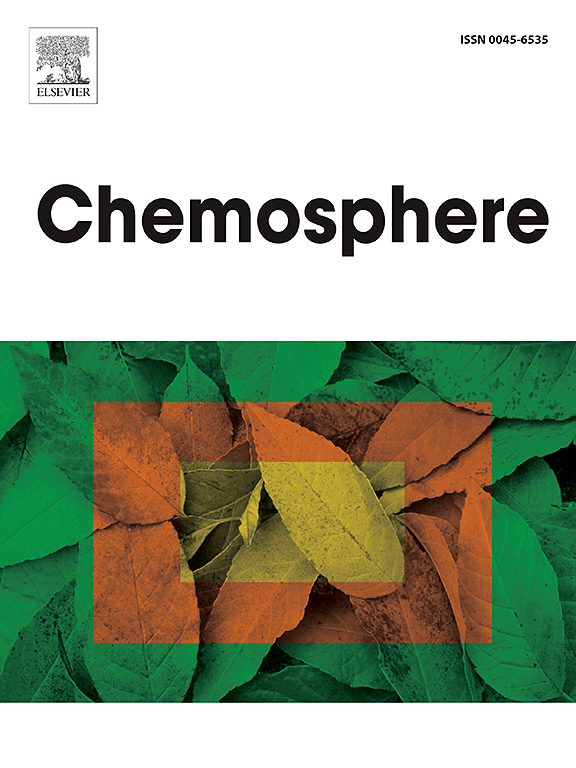Boral® 500 SC (sulfentrazone) induces accumulation of heme synthesis intermediates and changes in locomotor behavior and metabolic markers in Drosophila melanogaster
IF 8.1
2区 环境科学与生态学
Q1 ENVIRONMENTAL SCIENCES
引用次数: 0
Abstract
Sulfentrazone (SULF) is an herbicide that inhibits protoporphyrinogen oxidase, which is essential for the biosynthesis of chlorophyll and heme. Its prolonged soil half-life, low effective concentration, and the conserved nature of the heme biosynthesis pathway suggest that SULF might significantly affect non-target organisms. This study evaluated the impact of the commercial formulation Boral® 500 SC (SULF) on Drosophila melanogaster when exposed to acute concentrations. Fruit flies were exposed to 10–300 mg/L of the herbicide for seven days, which resulted in dose- and time-dependent increases in mortality. Following these results, further evaluations were conducted on flies exposed to 30 and 150 mg/L on the fourth day of treatment. The exposed flies exhibited decreased climbing locomotor capacity (negative geotaxis assay) and reduced exploratory locomotor capacity (open field assay), suggesting an increased energy demand to counteract the herbicide's effects. This was evidenced by decreased weight, reduced energy-rich molecules, and increased total protein levels. Activation of the heme biosynthesis pathway was indicated by the accumulation of protoporphyrin IX, increased total heme in the head, and induction of the porphobilinogen synthase (PBGS) enzyme (δ-aminolevulinic acid dehydratase, δ-ALA-D, in mammals). Biochemical analysis showed increased thiobarbituric acid reactive species (TBARS) levels and superoxide dismutase (SOD) activity in flies exposed to 150 mg/L, and higher glutathione-S-transferase (GST) activity in the 150 mg/L Top group. Additionally, there was an increase in MTT reduction assay in flies from the 150 mg/L Bottom group. The study highlights that species with significant diurnal activity, such as pollinators, might be especially susceptible to SULF exposure due to accumulated protoporphyrin IX and pro-oxidative activity under light conditions.

Boral®500 SC(磺胺曲酮)诱导黑腹果蝇血红素合成中间体的积累和运动行为和代谢标志物的变化
磺胺曲酮是一种抑制原卟啉原氧化酶的除草剂,原卟啉原氧化酶对叶绿素和血红素的生物合成至关重要。其较长的土壤半衰期、较低的有效浓度以及血红素生物合成途径的保守性表明,SULF可能对非目标生物产生显著影响。本研究评估了商业配方Boral®500 SC (SULF)在暴露于急性浓度时对黑胃果蝇的影响。果蝇暴露在10-300毫克/升的除草剂中7天,导致死亡率随剂量和时间的增加。根据这些结果,在第四天对暴露于30和150 mg/L的苍蝇进行了进一步的评估。暴露的果蝇表现出攀爬运动能力下降(负地向性试验)和探索运动能力下降(露天试验),表明能量需求增加以抵消除草剂的影响。这可以通过体重减轻、富含能量的分子减少和总蛋白质水平增加来证明。血红素生物合成途径的激活表现为原卟啉IX的积累,头部总血红素的增加,以及porphobilinogen合成酶(PBGS)酶(哺乳动物δ-氨基乙酰丙酸脱水酶,δ-ALA-D)的诱导。生化分析显示,150 mg/L Top组果蝇硫代巴比妥酸活性物质(TBARS)水平和超氧化物歧化酶(SOD)活性升高,150 mg/L Top组谷胱甘肽s转移酶(GST)活性升高。此外,在150 mg/L的底部组中,果蝇的MTT减少试验增加。该研究强调,由于在光照条件下积累的原卟啉IX和促氧化活性,传粉者等具有显著昼夜活动的物种可能特别容易受到硫代硫醚的影响。
本文章由计算机程序翻译,如有差异,请以英文原文为准。
求助全文
约1分钟内获得全文
求助全文
来源期刊

Chemosphere
环境科学-环境科学
CiteScore
15.80
自引率
8.00%
发文量
4975
审稿时长
3.4 months
期刊介绍:
Chemosphere, being an international multidisciplinary journal, is dedicated to publishing original communications and review articles on chemicals in the environment. The scope covers a wide range of topics, including the identification, quantification, behavior, fate, toxicology, treatment, and remediation of chemicals in the bio-, hydro-, litho-, and atmosphere, ensuring the broad dissemination of research in this field.
 求助内容:
求助内容: 应助结果提醒方式:
应助结果提醒方式:


